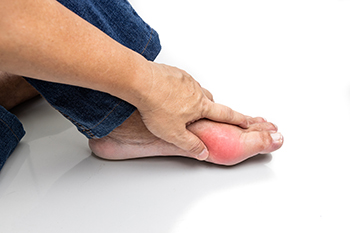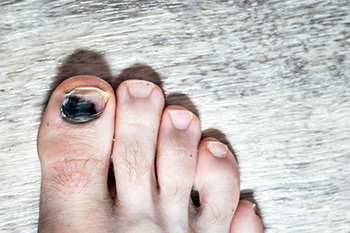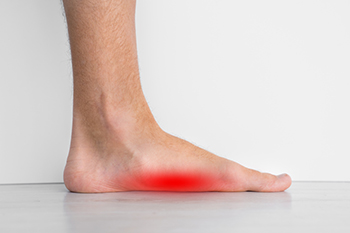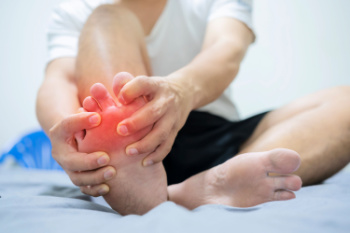Blog

Tophaceous gout is a severe form of gout that occurs when uric acid crystals accumulate in the joints and soft tissues, forming hardened lumps called tophi. These lumps can cause noticeable swelling and excruciating pain, which often leads to reduced mobility and increased joint stiffness. Tophaceous gout typically attacks the big toe and develops in people who have had untreated or poorly managed gout for years. Symptoms of gout include sudden intense pain, redness, and warmth surrounding the affected joint. Over time, repeated flares can lead to the formation of tophi, which may cause permanent joint damage if left untreated. A chiropodist can help manage the foot-related symptoms of gout by offering treatment options, advice on lifestyle changes, and suggestions for footwear to minimize discomfort. Managing uric acid levels and receiving regular care can prevent gout from progressing to more serious stages. If you have toe pain related to gout, it is suggested that you schedule an appointment with a chiropodist for advice on relief solutions.
Gout is a painful form of arthritis that can affect anyone. Please consult with one of the specialists from Thornhill Foot Clinic. Our chiropodists will assess your condition and provide you with quality foot and ankle treatment.
What Is Gout?
Gout is characterized by sudden, severe attacks of pain, redness, and tenderness in the joints. This type of arthritis is caused by a buildup of uric acid in the bloodstream. When uric acid crystallizes in a joint, often the joint of the big toe, it can bring about a gout attack.
Symptoms
Symptoms of gout include:
Sudden and severe pain
Swelling
Redness
Warmth
Joint stiffness
Joint deformity
Diagnosis
A chiropodist will ask questions about your personal and family medical history, followed by an examination of the affected joint. Laboratory tests and x-rays are sometimes ordered to determine if the inflammation is caused by something other than gout. A sample of fluid taken from your joint can show whether it contains uric acid.
Treatment
Prescription medications or injections are used to treat the pain, swelling, and inflammation. Patients with chronic gout can also use behavioral modifications such as diet, exercise, and decreased intake of alcohol to help minimize the frequency of gout attacks. Foods and beverages that are high in purines should be avoided since purines are converted in the body to uric acid. If left untreated, this painful condition can leave your joint permanently damaged and swollen.
If you have any questions, please feel free to contact our office located in . We offer the newest diagnostic and treatment technologies for all your foot care needs.

Running is a fantastic exercise, but it can sometimes lead to toenail injuries or loss, particularly among those who run frequently or wear ill-fitting shoes. Repeated pressure or trauma, often from shoes that are too tight or a long downhill run, can cause blood to pool under the nail, turning it black. In severe cases, a black toenail may become painful and detached from the nail bed. Other causes of black toenails include fungal infections, which thrive in warm, moist environments like sweaty running shoes, or underlying health conditions such as diabetes or heart disease. While mild cases may resolve on their own, a chiropodist can evaluate the cause and offer treatment options. These might include draining built-up blood, addressing fungal infections, or recommending better-fitting footwear to prevent future issues. If you have a black toenail related to running, it is suggested that you schedule an appointment with a chiropodist.
Toe pain is common and can have a variety of causes. Causes can range from a broken toe to an ingrown toenail. Many types of toe pain can be corrected, but any toe pain that inhibits your activities for an extended period should be discussed with a chiropodist. If you suffer from toe pain, please consult with one of the specialists from Thornhill Foot Clinic. Our chiropodists can help you maintain the health of your feet.
Common Causes of Toe Pain
- Trauma or fracture
- Cuts, sores, or bruises
- Rheumatoid arthritis
- Gout
- Turf Toe
- Morton’s neuroma
- Blisters
- Corns
- Bunions
- Hammertoes
- Ingrown toenails
- Plantar warts
- Athlete’s Foot
Symptoms of Toe Pain
- Toe deformity
- Burning
- Numbness
- Toenail deformity
- Wart or ulcer
- Swelling
- Redness
When to See a Chiropodist
- Bleeding or severe swelling
- Trauma, such as a broken bone
- Discoloration or extreme swelling
- Inability to bear weight
- Persistent pain
- Wounds that won’t heal
Diagnosis of Toe Pain
A chiropodist can conduct a thorough examination of the painful toe or toes in order to determine the best course of treatment. The exam may include assessing the tenderness of the area, taking an X-ray or other diagnostic test, or assessing your gait and range of motion. A discussion of what led to the advanced pain issue may follow. Included will likely be a health history, as well as a list of medications you are taking and other previous injuries you may have sustained.
Treatment for Toe Pain
With such a wide range of possible causes for toe pain, treatment can be varied in scope and length. Sometimes, the chiropodist will recommend lifestyle and activity changes. In cases of trauma or other injuries, X-rays or imaging tests will likely be used to determine the severity of the problem, particularly if any bones have been broken. Treatment may also include injections of pain-relief medication or anti-inflammatory drugs. Certain injuries will require the splinting, bracing, or wrapping of injured toes. Orthotics or special shoes may be prescribed in cases of bone deformities and gait issues. Removal of warts, calluses, and corns may be needed. In other cases, such as with patients who have diabetes or rheumatoid arthritis, ongoing treatment may be required to avoid more serious problems.

Rehabilitating foot injuries, such as lateral ankle sprains, in athletes requires a strategic approach to restore strength, stability, and proper gait mechanics. Once the acute phase subsides, targeted exercises are essential for recovery. Strengthening exercises, such as resistance band workouts for the ankle and foot, help rebuild muscle support around the injured area. Balance and proprioception exercises, like standing on one leg or using a balance board, are important for restoring stability and preventing future injuries. Gait mechanics must also be addressed during rehabilitation. Athletes should work on correcting any abnormal walking or running patterns that may have developed due to the injury. This can involve gait analysis and guided retraining to ensure proper foot alignment and motion. Gradual return to sport-specific activities under professional supervision is key to ensuring a safe and effective recovery, reducing the risk of reinjury. If you are an athlete who has sustained a foot or ankle injury, it is suggested that you see a chiropodist for a proper diagnosis and care.
Injuries to the foot and ankle are very common among athletes. If you have experienced an injury, please consult with one of the specialists from Thornhill Foot Clinic. Our chiropodists will assess your condition and provide you with quality foot and ankle treatment.
Common Injuries Among Athletes:
Achilles tendon injuries
Ankle strains or sprains
Plantar fasciitis
Fractures
Turf toe
Joint dislocations
Sever’s disease
Morton’s neuroma
Symptoms
Symptoms will depend on the cause and severity of the injury. Common symptoms for a foot or ankle injury include pain, swelling, tenderness, bruising, a reduced range of motion, and difficulty bearing weight or walking on the affected foot or ankle.
Diagnosis
Sports injuries are typically diagnosed after carefully examining the affected foot or ankle. This includes moving the injured area to test its range of motion. Medical history will need to be provided, as well as detailed information about how the injury occurred. Imaging studies, such as X-rays or MRIs, may be used to confirm or rule out certain diagnoses.
Treatment
Just like symptoms, treatment will depend on the type of injury and its severity. Initial treatment for many sports injuries is aimed at controlling inflammation and promoting the healing response. The acronym R.I.C.E is a helpful guide to implement for most acute injuries. This method involves resting, icing, compressing, and elevating the affected foot or ankle. In addition, anti-inflammatory medications may be administered and orthotic devices may be prescribed. For more severe injuries, surgery may be required. Lastly, rehabilitation or physical therapy may be needed to gain full functionality in the afflicted area.
If you have any questions, please feel free to contact our office located in . We offer the newest diagnostic and treatment technologies for all your foot care needs.

Athlete’s foot, medically known as tinea pedis, is a fungal infection affecting the skin on the feet. The condition typically causes itching, redness, and peeling between the toes and the soles of the feet. There are several types of athlete’s foot, including interdigital, which affects the spaces between the toes. Another type of athlete’s foot, called moccasin, causes thickening and scaling on the soles. Vesicular athlete’s foot results in fluid-filled blisters. Risk factors for developing all types of athlete’s foot include wearing damp or tight-fitting shoes, walking barefoot in communal areas like pools or gyms, and having a weakened immune system. Fungal infections thrive in warm, moist environments, making sweaty feet particularly susceptible. If you have developed athlete’s foot, it is suggested that you consult a chiropodist for treatment.
Athlete’s foot can be uncomfortable and unsightly. To learn more about preventing and treating this condition, please consult with one of the specialists from Thornhill Foot Clinic. Our chiropodists will assess your condition and provide you with quality foot and ankle treatment.
What Is Athlete’s Foot?
Athlete’s foot refers to an infection of the skin on the feet that is caused by a fungus. This fungus is contagious and thrives in warm and moist environments. It is often spread in common areas such as public pools, locker rooms, and showers. It can also spread when sharing personal items, like shoes or towels, with an infected person.
Symptoms
The symptoms of athlete’s foot may include:
Itching, stinging, or burning of the skin on the feet
Cracking or peeling skin, especially between the toes and on the soles of the feet
Scaly, red rash on the foot
Blisters
Foul odor
Treatment
Treatment for athlete’s foot typically involves using over-the-counter topical antifungal medications on the feet. When over-the-counter options are ineffective, you may need to take prescription oral medications or topical antifungal drugs, or a combination of both.
Prevention
Preventing athlete’s foot places an emphasis on good foot hygiene practices.
You can prevent athlete’s foot by:
Washing and drying your feet thoroughly every day
Wearing shoes when walking in public areas
Not sharing personal items, like shoes or socks, with others
Wearing shoes and socks made out of breathable materials
If you have any questions, please feel free to contact our office located in . We offer the newest diagnostic and treatment technologies for all your foot care needs.

Adult acquired flatfoot deformity is a condition where the arch of the foot collapses, leading to a flattening of the foot's structure over time. This deformity can result from various risk factors, including diabetes, which can cause nerve damage and poor circulation affecting foot mechanics. Obesity adds extra stress to the foot's structure, worsening the condition. Aging contributes to the natural degeneration of bones and joints, weakening the support structures of the foot. Additionally, degeneration of the tendons and ligaments, particularly the posterior tibial tendon, plays a significant role in the development of this deformity. If you have flat feet, it is suggested that you are under the care of a chiropodist who can help you to manage this condition.
Flat feet are a common foot condition. If you are experiencing pain or discomfort due to flat feet, please consult with one of the specialists from Thornhill Foot Clinic. Our chiropodists will assess your condition and provide you with quality foot and ankle treatment.
What Are Flat Feet?
Flat feet are feet that do not have a well-defined arch in the middle of the sole of the foot. Flat feet may be flexible or rigid. Flexible flat feet have an arch when there is no pressure put on the foot, such as when one is sitting, but the arch disappears upon standing. Rigid flat feet lack an arch regardless of whether one is standing or not.
Causes
Flat feet can be present from birth or acquired over time due to a weakening of the ligaments in the arch. Sometimes flat feet are caused by illnesses, injuries, or pregnancy.
Symptoms
Flat feet often cause no noticeable symptoms. However, some people may experience pain and discomfort due to their flat feet.
Symptoms associated with flat feet include:
Pain in the arch, heel, ankle, or along the outside of the foot
Overpronation of the foot
Shin splints
Aching or fatigue in the feet or legs
Pain in the knees, hips, or lower back
Treatment
In cases where flat feet cause symptoms, there are various treatments available. Wearing orthotic inserts in your shoes to provide more arch support, performing stretches, and taking medications may improve your symptoms. If you are overweight, losing weight can help relieve pressure on the feet. In severe cases, surgery may be considered.
If you have any questions, please feel free to contact our office located in . We offer the newest diagnostic and treatment technologies for all your foot care needs.

Plantar fasciitis is a common foot condition caused by inflammation of the plantar fascia, a thick band of connective tissue that runs from the heel to the toes. This inflammation typically arises from excessive strain or overuse of the foot. The primary symptom of plantar fasciitis is sharp, stabbing pain in the heel, especially noticeable with the first steps in the morning or after sitting for extended periods of time. As the day progresses, the pain may decrease but can return after long periods of standing or walking. The discomfort is often accompanied by stiffness and swelling in the heel area. Recognizing these symptoms early and seeking appropriate treatment is essential for recovery. If you have heel pain, it is suggested that you confer with a chiropodist who can diagnose and treat plantar fasciitis.
Plantar fasciitis can be painful and interfere with your daily activities. If you are experiencing foot or heel pain and believe you may be afflicted with plantar fasciitis, please consult with one of the specialists from Thornhill Foot Clinic. Our chiropodists will assess your condition and provide you with quality foot and ankle treatment.
What Is Plantar Fasciitis?
Plantar fasciitis refers to the inflammation of the plantar fascia, a ligament that runs along the bottom of the foot and connects the heel bone to the toes. Repetitive activities, such as running or jumping, can injure the plantar fascia over time. Plantar fasciitis can also be caused by flat feet, high arches, pregnancy, and activities that put excessive pressure on your feet, like standing all day for work. When the plantar fascia becomes inflamed, it causes pain and discomfort.
Symptoms
Typical symptoms of plantar fasciitis include:
Stabbing pain near the heel
Pain that is worst in the morning or after a period of rest
Pain that increases after exercising
Swelling
Tightness in the Achilles tendon
Diagnosis
Plantar fasciitis is typically diagnosed via medical history and physical examination.
Treatment
Treatments for plantar fasciitis include resting and icing the affected foot, stretching the foot, taking medications to reduce inflammation, and wearing orthotics. In severe cases where pain does not improve with conservative treatments, injections or surgery may be recommended.
If you have any questions, please feel free to contact our office located in . We offer the newest diagnostic and treatment technologies for all your foot care needs.

Dancers frequently develop foot blisters due to the intense physical activity and friction involved in their performances and practices. Blisters form when repeated rubbing or pressure causes the skin layers to separate, allowing fluid to collect beneath. The combination of wearing tight-fitting shoes, excessive moisture from sweat, and rigorous foot movements heightens the risk. To prevent blisters, dancers should ensure their footwear fits properly and provides adequate support. Using moisture-wicking socks and applying blister prevention tape or pads can also help reduce friction. Additionally, keeping feet dry and maintaining proper foot hygiene can minimize the risk of blisters. Regularly checking feet for any signs of irritation and addressing it promptly can further prevent the development of blisters and ensure healthier, more comfortable dancing experiences. If you enjoy dancing and have developed foot blisters, it is suggested that you schedule an appointment with a chiropodist who can offer effective treatment techniques, in addition to specific blister prevention methods.
Blisters can usually be treated at home, however, if you have recurring blisters or experience significant discomfort or pain, please consult with one of the specialists from Thornhill Foot Clinic. Our chiropodists will assess your condition and provide you with quality foot and ankle treatment.
What Is a Blister?
A blister is a small pocket of fluid in the upper skin layers and is one of the body’s natural responses to injury or pressure. Blisters can also result from burns, fungal or viral skin infections, and the feet are particularly prone due to ill-fitting footwear and friction. Friction on the skin causes the upper layer of skin to separate from the lower layers. The space that this separation creates then becomes filled with a liquid called serum, which protects the lower layers of skin.
Treatment
If you notice a blister on your foot, you can cover it with a soft bandage or dressing to protect it. Popping the blister is discouraged. Doing so exposes the raw skin underneath it to bacteria and also raises the risk of infection. If a blister pops naturally, let it drain before covering it with a bandage. Blisters usually heal on their own or with home treatment, however, if your blister is recurring, very painful, or appears infected, it is recommended that you see a chiropodist for treatment.
Prevention
You can help to prevent blisters by wearing comfortable, well-fitted shoes. Keep your feet dry by wearing moisture-wicking socks and dust your feet with talcum powder if they tend to get sweaty. If you have areas on your feet that are more susceptible to blisters, you might be able to prevent the blister from forming by covering it with a pad.
If you have any questions, please feel free to contact our office located in . We offer the newest diagnostic and treatment technologies for all your foot care needs.

Toe pain can stem from various causes, each affecting comfort and mobility. Bunions, which are bony bumps at the base of the big toe, can lead to significant discomfort and swelling, often exacerbated by wearing narrow or poorly fitting shoes. Corns, which are thickened areas of skin that develop on the toes due to friction, can also cause pain, particularly when walking. Arthritis, particularly osteoarthritis and rheumatoid arthritis, can result in joint inflammation and stiffness, making toe movement painful and challenging. Additionally, wearing shoes that do not fit properly, whether too tight, too loose, or with inadequate support can contribute to a range of toe problems, including blisters, calluses, and general pain. If you have developed toe pain, it is suggested that you consult a chiropodist who can make a proper diagnosis and offer effective treatment solutions.
Toe pain is common and can have a variety of causes. Causes can range from a broken toe to an ingrown toenail. Many types of toe pain can be corrected, but any toe pain that inhibits your activities for an extended period should be discussed with a chiropodist. If you suffer from toe pain, please consult with one of the specialists from Thornhill Foot Clinic. Our chiropodists can help you maintain the health of your feet.
Common Causes of Toe Pain
- Trauma or fracture
- Cuts, sores, or bruises
- Rheumatoid arthritis
- Gout
- Turf Toe
- Morton’s neuroma
- Blisters
- Corns
- Bunions
- Hammertoes
- Ingrown toenails
- Plantar warts
- Athlete’s Foot
Symptoms of Toe Pain
- Toe deformity
- Burning
- Numbness
- Toenail deformity
- Wart or ulcer
- Swelling
- Redness
When to See a Chiropodist
- Bleeding or severe swelling
- Trauma, such as a broken bone
- Discoloration or extreme swelling
- Inability to bear weight
- Persistent pain
- Wounds that won’t heal
Diagnosis of Toe Pain
A chiropodist can conduct a thorough examination of the painful toe or toes in order to determine the best course of treatment. The exam may include assessing the tenderness of the area, taking an X-ray or other diagnostic test, or assessing your gait and range of motion. A discussion of what led to the advanced pain issue may follow. Included will likely be a health history, as well as a list of medications you are taking and other previous injuries you may have sustained.
Treatment for Toe Pain
With such a wide range of possible causes for toe pain, treatment can be varied in scope and length. Sometimes, the chiropodist will recommend lifestyle and activity changes. In cases of trauma or other injuries, X-rays or imaging tests will likely be used to determine the severity of the problem, particularly if any bones have been broken. Treatment may also include injections of pain-relief medication or anti-inflammatory drugs. Certain injuries will require the splinting, bracing, or wrapping of injured toes. Orthotics or special shoes may be prescribed in cases of bone deformities and gait issues. Removal of warts, calluses, and corns may be needed. In other cases, such as with patients who have diabetes or rheumatoid arthritis, ongoing treatment may be required to avoid more serious problems.
Blog Archives
- 2025
- 2024
- 2023
- 2022
- 2021


